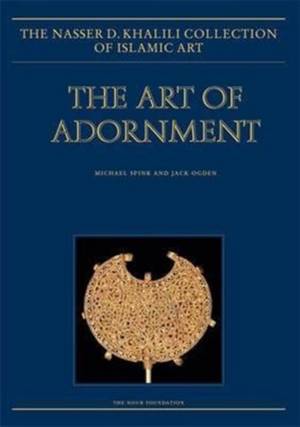
- Retrait gratuit dans votre magasin Club
- 7.000.000 titres dans notre catalogue
- Payer en toute sécurité
- Toujours un magasin près de chez vous
- Retrait gratuit dans votre magasin Club
- 7.000.000 titres dans notre catalogue
- Payer en toute sécurité
- Toujours un magasin près de chez vous
The Art of Adornment
Jewellery of the Islamic Lands, Parts 1 and 2, 2013
Michael Spink, Jack Ogden, J M Rogers, Mark G Kramarovsky, Pedro Moura Carvalho, Manijeh Bayani
198,95 €
+ 397 points
Description
The Collection provides an unrivalled resource for the study of Islamic jewellery, with nearly 600 catalogued pieces in gold, silver and copper alloys, of all periods from the 7th to the 20th centuries and from throughout the Islamic world - Spain to Malaysia, and Africa to the Eurasian steppes. Various sectors of production and clienteles are represented, from the court to bespoke jewellery to the urban marketplace. The jewellery also illustrates a correspondingly wide range of techniques and materials, including all the main methods of working gold, silver and copper alloys and their decoration - especially filigree, niello, enamel and the setting of gems. Inevitably some periods, areas and techniques are better represented than others, but overall the Collection is remarkably comprehensive and in some areas, such as the Fatimid filigree, is among the finest in the world.
This two-part volume includes virtually every form of personal adornment - head, hair and headdress ornaments; earrings; nose rings; finger rings; pendants; beads; necklaces; bracelets, armlets and anklets; armband elements; amulets and amulet cases; pins and brooches; buttons; belts and belt fittings - as well as harness fittings. Separate volumes in the Nasser D. Khalili Collection of Islamic Art series have been devoted to rings (vol. XVI) and the jewellery from Mughal India (vol. XVIII); more of the belt and harness fittings were included in the study of arms and armour (vol. XXI).
Outstanding among the Khalili Collection jewellery are the Fatimid pieces, which include a pair of gold pins with extraordinarily fine vegetal designs rendered in the characteristic rope-and-grain filigree of Egypt or Syria; the many bracelets of the 10th-early 13th centuries, including exceptional ones of gold sheet set with gems and decorated with inlaid niello and granulation made in Iran; the gold and silver repoussé huntsmen's belt fittings from the Golden Horde Central Asia or the Qipchaq steppe, with clear Khitan or Jin influence; a larger number of enamelled and gilded copper-alloy belt and harness fittings from Nasrid Spain than in most other collections; an exquisite two-headed eagle in gold filigree set with emeralds from 18th-century Morocco; and a large group of Iranian enamelled jewellery of the Qajar period, including excellent enamelled pendants with portraits of the Qajar Shahs.
In addition to Michael Spink's expertise in Islamic art and jewellery across its full geographical range brought to bear throughout the catalogue, Jack Ogden's comprehensive knowledge of ancient jewellery and jewellery technology is reflected in two important surveys of techniques and materials. Mark G. Kramarovksy contributed an important discussion of the origins of the 'spiral filigree' style. Pedro Moura Carvalho reviewed the evidence for enamelling in Iran under the Safavid and Zand dynasties. J.M. Rogers made numerous additions, most notably his survey of the documentation of Ottoman jewellery, and with Manijeh Bayani have made the text of Nishaburi on medieval enamelling accessible to a wider audience.
This two-part volume includes virtually every form of personal adornment - head, hair and headdress ornaments; earrings; nose rings; finger rings; pendants; beads; necklaces; bracelets, armlets and anklets; armband elements; amulets and amulet cases; pins and brooches; buttons; belts and belt fittings - as well as harness fittings. Separate volumes in the Nasser D. Khalili Collection of Islamic Art series have been devoted to rings (vol. XVI) and the jewellery from Mughal India (vol. XVIII); more of the belt and harness fittings were included in the study of arms and armour (vol. XXI).
Outstanding among the Khalili Collection jewellery are the Fatimid pieces, which include a pair of gold pins with extraordinarily fine vegetal designs rendered in the characteristic rope-and-grain filigree of Egypt or Syria; the many bracelets of the 10th-early 13th centuries, including exceptional ones of gold sheet set with gems and decorated with inlaid niello and granulation made in Iran; the gold and silver repoussé huntsmen's belt fittings from the Golden Horde Central Asia or the Qipchaq steppe, with clear Khitan or Jin influence; a larger number of enamelled and gilded copper-alloy belt and harness fittings from Nasrid Spain than in most other collections; an exquisite two-headed eagle in gold filigree set with emeralds from 18th-century Morocco; and a large group of Iranian enamelled jewellery of the Qajar period, including excellent enamelled pendants with portraits of the Qajar Shahs.
In addition to Michael Spink's expertise in Islamic art and jewellery across its full geographical range brought to bear throughout the catalogue, Jack Ogden's comprehensive knowledge of ancient jewellery and jewellery technology is reflected in two important surveys of techniques and materials. Mark G. Kramarovksy contributed an important discussion of the origins of the 'spiral filigree' style. Pedro Moura Carvalho reviewed the evidence for enamelling in Iran under the Safavid and Zand dynasties. J.M. Rogers made numerous additions, most notably his survey of the documentation of Ottoman jewellery, and with Manijeh Bayani have made the text of Nishaburi on medieval enamelling accessible to a wider audience.
Spécifications
Parties prenantes
- Auteur(s) :
- Editeur:
Contenu
- Nombre de pages :
- 2
- Langue:
- Anglais
- Collection :
- Tome:
- n° 17
Caractéristiques
- EAN:
- 9781874780861
- Date de parution :
- 12-08-13
- Format:
- Livre relié
- Format numérique:
- Genaaid
- Dimensions :
- 269 mm x 373 mm
- Poids :
- 7121 g







